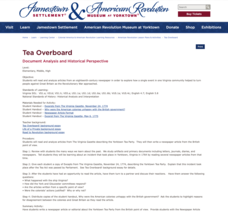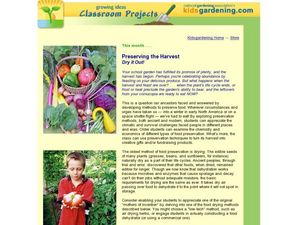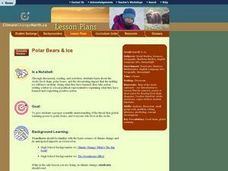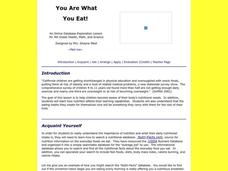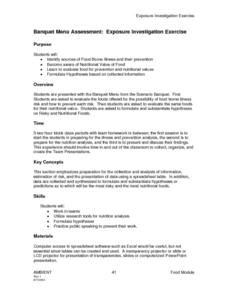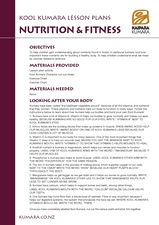Biology in Motion
ATP and Energy Storage
Young children often appear to have endless amounts of energy. The interactive describes where energy comes from and how bodies turn food into a usable energy source. The comparison of ATP to a rechargeable battery helps pupils remember...
Jamestown-Yorktown Foundation
Tea Overboard
While less well known than the event in Boston, the Yorktown Tea Party was equally decisive in turning community sentiment against Great Britain. To gain an understanding of why the colonists objected to the Tea Act, young historians...
Howard Hughes Medical Institute
How the Body Uses Fat
Not all fat is bad—eating good fats actually helps with weight loss. Learn how the body uses fat through a 27-slide presentation that breaks down the path fat takes from entering to exiting the body. Understanding why fat is helpful and...
Curated OER
What is Energy?
Youngsters take a look at the foods they eat, and how they provide energy for them to do things. They look at how body uses the food energy to create movement. Pupils also look at toys/devices in the room that need electrical energy...
Curated OER
Making Pretzels
Young scholars explore how people use plants for food. They use pretzels to see how wheat can be turned into food.
Curated OER
Steps to a Healthier You
Students explore the food pyramid. In this dietary health lesson plan, students examine the food pyramid on the MyPyramid.gov website and discuss healthy eating strategies. There are various links to websites in this lesson plan.
Curated OER
Meats Make Muscles
Second graders explore the meat group of the food pyramid. In this nutrition and diet lesson, 2nd graders study the benefits of eating foods in the meat group, collect data regarding their classmates' favorite foods, and create a graph...
Curated OER
Preserving the Harvest: Dry it Out!
Students explore how people preserved their food in the past. In food preservation instructional activity, students create different models that enable someone to dry out food, such as a food dehydrator. Students also learn how to...
Curated OER
Civil War Recipes
Students make foods that would have been staples during the Civil War era and may have been eaten by a soldiers. They follow a recipe to make hardtack and are exposed to other recipes at the included websites.
Curated OER
Polar Bears and Ice
Students explore the Arctic food chain. They examine the needs of the polar bear and the threat that global warming poses to them. Students write a letter to a local political representative explaining what they have studied and...
Curated OER
You Are What You Eat!
Fourth graders discover the nutritional needs of their bodies. Using a database, they research how nutrition affects their learning capabilities. They take the food they eat on a daily basis and discover its nutritional value. They...
Curated OER
Basic Vitamins: Water-Soluble and Fat-Soluble
Students examine vitamins and study their functions and food sources. They research what happens to vitamins when foods are overcooked. They prepare a microwaveable vegetable quiche.
Curated OER
Meat, Poultry, Fish, Eggs: Constructing and Maintaining
Meat as a food source to provide necessary complete protein, iron, and other nutrients in the diet. Identify and prepare meats and/or poultry product(s). National Standard 14.3.3
Curated OER
Fruit and Vegetable, Vitamins and Minerals
Students discuss and identify vitamins and minerals, their functions in the body, how fruits and vegetables are a good food source, and deficiencies in the body that may occur due to a lack of them.
Curated OER
Banquet Menu Assessment: Exposure Investigation Exercise
Learners identify sources of Food Borne illness and their prevention. They formulate hypotheses based on collected information. Pupils become aware of Nutrintional value of food. Students collected data are synthesized to formulate...
Curated OER
Sea-ing More Clearly
Students explore historical importance of fish as food source, examine works of Robert Harris, create their own fish, and compose accompanying poetry. Students then explore dramatic tradition of Chorus inspired by Greek theatre,...
Curated OER
Benne Cakes and Other Holiday Recipes
Benne Cakes, a West African treat packed with sesame seeds for luck, are a featured part of the celebration of Kwanzaa. Young chefs try their hand at crafting these goodies that are sure to enrich your holiday feast.
Curated OER
The Artemia Hatchery
Students, in groups, develop their hatcheries, working cooperatively in its design and construction. The lessons begin with the introduction to Artemia as a primary food source of many aquaculture species during their larval stages.
Curated OER
Topography of Africa
Students study Africa's diverse landscape and investigate how these features impact the available water supply, food sources, and population distribution of the continent. They compare topographical features and
their affect on each...
Curated OER
Mollusk Matching
Students look carefully at shells and observe the differences between
species and the names of common shells. Then they identify and complete a Mollusk Matching handout included in the lesson and write the letter of each shell in the...
Curated OER
Farm Products Help Me Grow
Students view a display of empty food containers (or illustrations). They select a food and decide as a class if it has an animal or plant origin. Students view a display of common farm animals that are commonly eaten (cow, pig, chicken,...
Curated OER
Plants 'R' Us!
Students investigate the interdependencies of plants and animals, and study what a food web is. They create a food web using yarn and images.
Curated OER
Making Pretzels
Students discover that plants provide food products to humans. In this baking lesson, students grind wheat seeds into flour and then use the flour to make pretzels. Students participate in a variety of activities that involve them in...
Curated OER
Nutrition and Fitness
Sixth graders investigate the food guide pyramid. They conduct Internet research, and plan a three day nutritional menu appropriate for teenagers. Students include three meals per day and a snack for each day on their menu, and...



